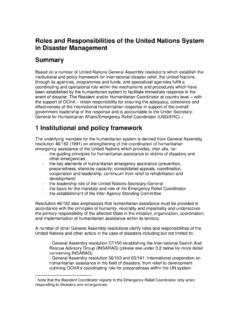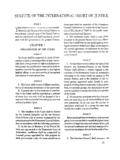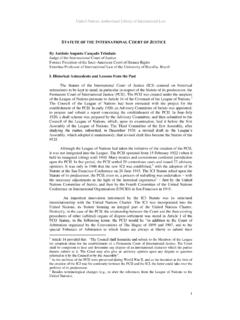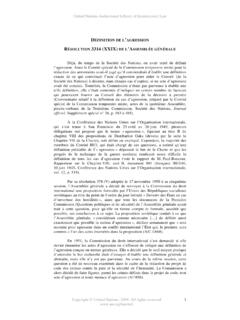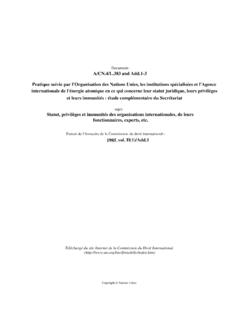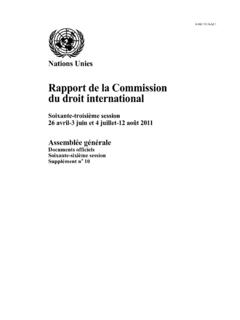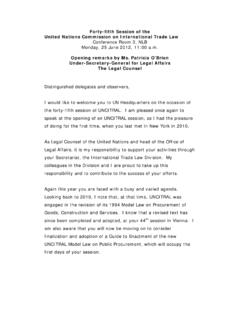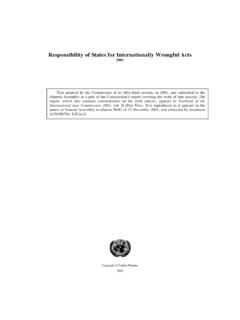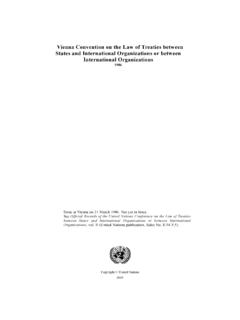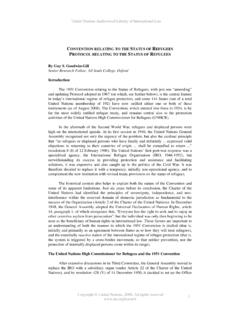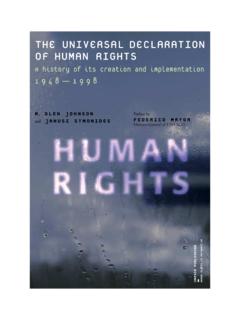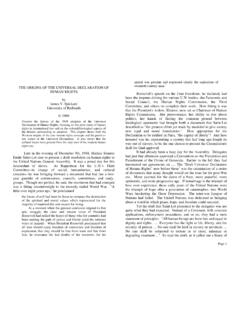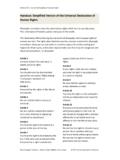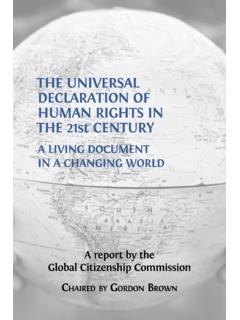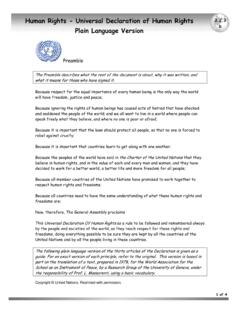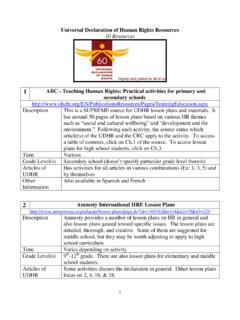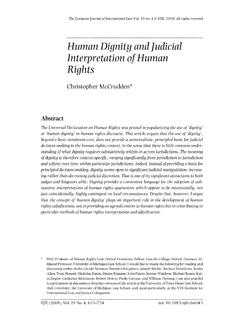Transcription of UNIVERSAL DECLARATION OF HUMAN RIGHTS
1 United Nations Audiovisual Library of International Law UNIVERSAL DECLARATION OF HUMAN RIGHTS By Ant nio Augusto Can ado Trindade Former President of the Inter-American Court of HUMAN RIGHTS When the General Assembly of the United Nations adopted, on 10 December 1948, the UNIVERSAL DECLARATION of HUMAN RIGHTS , in one of the brief spells of enlightenment in the twentieth century, one could hardly anticipate that a historical process of generalization of the international protection of HUMAN RIGHTS was being launched, on a truly UNIVERSAL scale.
2 Throughout the last six decades, of remarkable historical projection, the DECLARATION has gradually acquired an authority which its draftsmen could not have foreseen. This happened, not only because of the persons who participated in its elaboration, nor because of the form which was given to that historical document, nor because of the circumstances of its adoption: it happened mainly because successive generations of HUMAN beings, from distinct cultures and all over the world, recognized in it a common standard of achievement (as originally proclaimed), which corresponded to their deepest and most legitimate aspirations.
3 Already throughout the travaux pr paratoires of the UNIVERSAL DECLARATION (particularly in the thirteen months between May 1947 and June 1948), the holistic view of all RIGHTS to be proclaimed promptly prevailed. Such outlook was espoused in the official preparatory work of the DECLARATION , that is, the debates and drafting in the United Nations Commission on HUMAN RIGHTS and subsequently in the Third Committee of the General Assembly. In addition, in 1947, in a contribution to the work then in course in the Commission on HUMAN RIGHTS , the United Nations Educational, Scientific and Cultural Organization undertook an examination of the main theoretical problems raised by the elaboration of the UNIVERSAL DECLARATION .
4 It circulated, to some of the most influential thinkers of the time around the world, a questionnaire on the relations between RIGHTS of individuals and groups in societies of different kinds and in distinct historical circumstances, as well as the relations between individual freedoms and social or collective responsibilities. Some of the answers to the questionnaire singled out the interdependence of all HUMAN RIGHTS , the guarantee of freedom of the individual in face of the forces of collectivity and of situations of adversity, and the relations between RIGHTS and duties.
5 The 1948 UNIVERSAL DECLARATION stressed the interdependence of all HUMAN RIGHTS (civil, political, economic, social and cultural), all inherent in the HUMAN person. Shortly after its adoption, conceived as the first of a three-part International Bill of HUMAN RIGHTS (that was to be followed by a Convention which later resulted in the adoption of the two Covenants and measures of implementation), the deep ideological divisions of the world of the 1950s led to the categorization of HUMAN RIGHTS .
6 It was not until the first International Conference on HUMAN RIGHTS (Teheran, April to May, 1968), two decades after the adoption of the UNIVERSAL DECLARATION , that the reassertion of the holistic view and interrelatedness of all HUMAN RIGHTS (nowadays universally acknowledged) took place, in a world then divided by the bipolarity characteristic of the cold war. Such reassertion, reiterated in successive resolutions of the United Nations General Assembly, has generated a considerable transformation in the Copyright United Nations, 2008.
7 All RIGHTS reserved 1 United Nations Audiovisual Library of International Law treatment of HUMAN RIGHTS matters at the international level ever since. When the 1968 Teheran Proclamation forcefully advanced the thesis of the indivisibility of all HUMAN RIGHTS , it was rescuing the basic philosophy underlying the UNIVERSAL DECLARATION in this regard. With the gradual adoption of United Nations sectoral HUMAN RIGHTS conventions and the operation of several international supervisory organs thereunder, it was not surprising that, 25 years after Teheran, the DECLARATION and Programme of Action of Vienna, adopted by the second World Conference on HUMAN RIGHTS (Vienna, June 1993)
8 , was marked by the recognition of the necessity to achieve a better coordination of the several international instruments of protection, which had coexisted in the previous two and a half decades. The Teheran Proclamation corresponded to the legislative phase, and the Vienna DECLARATION and Programme of Action to the implementation phase, of those multiple instruments of protection. Each one is a product and testament of its time. The second World Conference concentrated its attention on the means to secure the effectiveness of HUMAN RIGHTS in practice, with special attention turned to discriminated or disadvantaged persons, to vulnerable groups, to the poor and to all those who are socially marginalized or excluded, in sum, to those in greater need of protection.
9 It gave concrete expression to the interdependence of all HUMAN RIGHTS and their universality (enriched by cultural diversity). The 1948 UNIVERSAL DECLARATION of HUMAN RIGHTS is widely recognized as having inspired, and paved the way for, the adoption of more than seventy HUMAN RIGHTS treaties, applied today on a permanent basis at global and regional levels (all containing references to it in their preambles). In addition, the UNIVERSAL DECLARATION served as a model for the enactment of numerous HUMAN RIGHTS norms in national constitutions and legislations, and helped to ground decisions of national and international courts.
10 The UNIVERSAL DECLARATION , moreover, is today widely recognized as an authoritative interpretation of HUMAN RIGHTS provisions of the Charter of the United Nations itself, heralding the transformation of the social and international order to secure the enjoyment of the proclaimed RIGHTS . General awareness was gradually formed of the existence of RIGHTS which are inherent in all HUMAN beings, which thus pre-exist, and stand above, the State and all forms of political organization.
